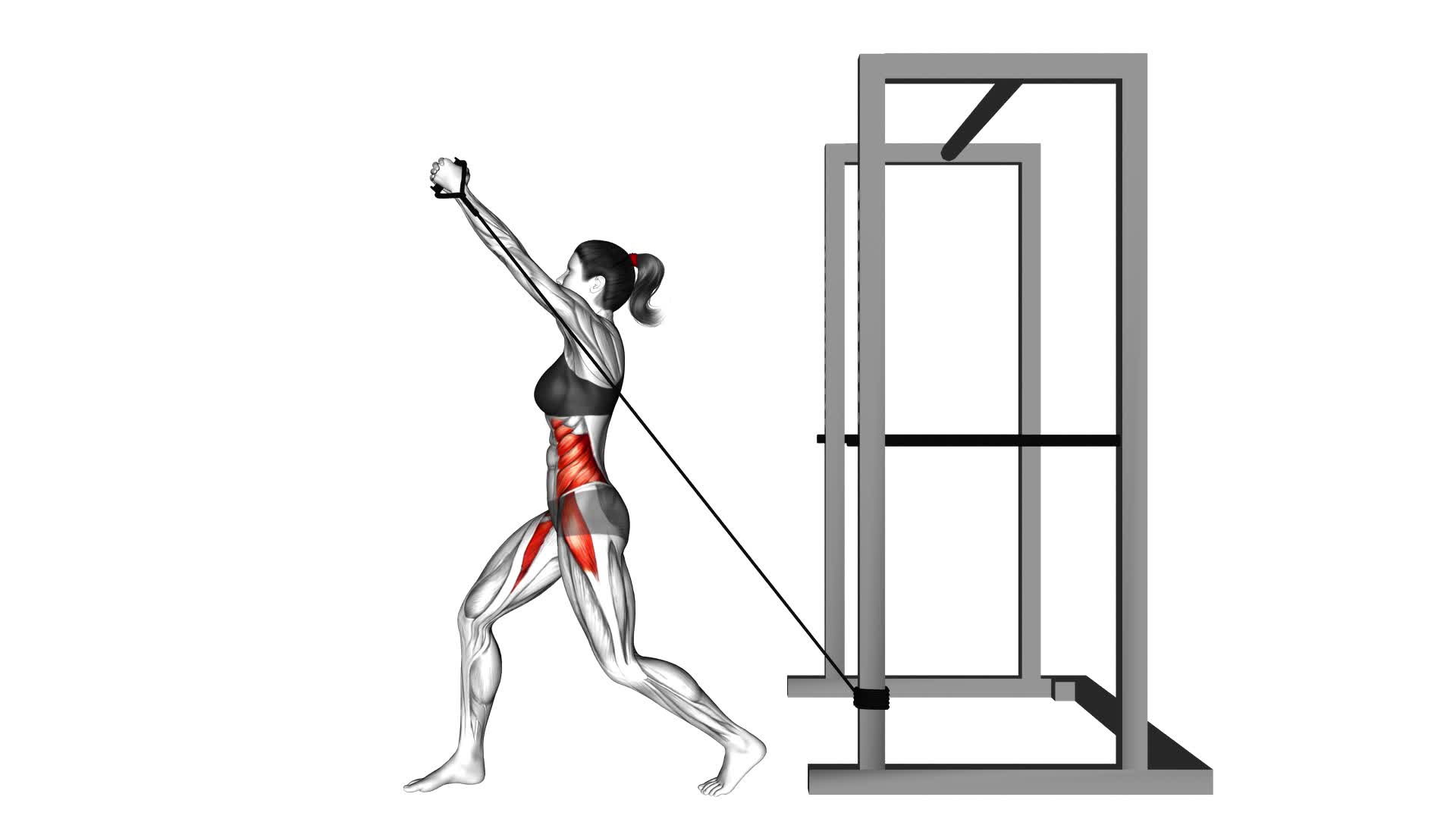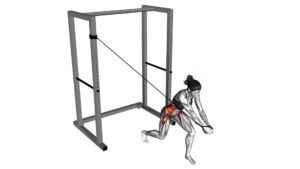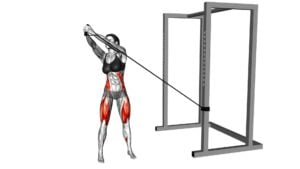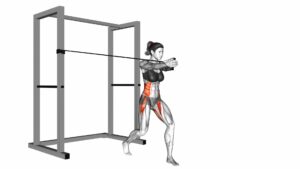Band Twist (Down-Up) (Female) – Video Exercise Guide & Tips

Are you looking for a new exercise to target your core muscles? Look no further than the Band Twist (Down-Up) exercise.
Watch This Exercise Video
This video exercise guide will show you the proper form and technique to perform this exercise effectively.
With just a resistance band and a little motivation, you can strengthen your abs and obliques in no time.
Don't let your fitness routine become stagnant – try the Band Twist (Down-Up) and feel the burn today.
Key Takeaways
- Band Twist (Down-Up) exercise strengthens core muscles.
- Band Twist (Down-Up) exercise improves balance and posture.
- Band Twist (Down-Up) exercise enhances overall strength and stability.
- Band Twist (Down-Up) exercise targets rotational strength and improves the ability to generate and transfer force through rotational movements.
Benefits of Band Twist (Down-Up) Exercise
One major benefit of the Band Twist (Down-Up) exercise is that it strengthens your core muscles. The importance of core engagement during this exercise can't be overstated. When you perform the Band Twist (Down-Up), you're actively engaging your core muscles to stabilize and control the movement. This not only helps to improve your balance and posture but also enhances your overall strength and stability.
The Band Twist (Down-Up) exercise specifically targets your rotational strength. As you twist and rotate your torso while holding the resistance band, you're activating the muscles in your core, including the obliques and deep abdominal muscles. This exercise helps to improve your ability to generate and transfer force through rotational movements, which can be beneficial in sports and everyday activities that involve twisting or turning motions.
Equipment Needed for Band Twist (Down-Up) Exercise
To perform the Band Twist (Down-Up) exercise, you'll need a resistance band. Resistance bands are versatile and effective tools for strength training and core strengthening. They come in various levels of resistance, allowing you to adjust the intensity of your workout. The band provides resistance throughout the movement, challenging your muscles and helping to build strength and stability in your core.
When choosing a resistance band for the Band Twist (Down-Up) exercise, it's important to consider your fitness level and goals. Beginners may start with a lighter resistance band, while more advanced individuals may opt for a higher resistance level. It's recommended to choose a band that provides enough resistance to make the exercise challenging, but not too difficult to perform with proper form.
Resistance bands are lightweight and portable, making them convenient to use at home, in the gym, or even while traveling. They're also affordable and can be easily purchased online or at fitness stores. Before starting the Band Twist (Down-Up) exercise, ensure that your resistance band is securely anchored to a sturdy object or held firmly by a partner to prevent any accidents or injuries.
Proper Form and Technique for Band Twist (Down-Up) Exercise
For proper form and technique in the Band Twist (Down-Up) exercise, focus on maintaining a stable core and engaging your muscles throughout the movement. This exercise targets your obliques, shoulders, and back.
To perform the Band Twist (Down-Up) exercise, start by attaching a resistance band to a sturdy anchor point. Stand facing the anchor with your feet shoulder-width apart and hold the band with both hands in front of your chest. Keep your arms extended and your elbows slightly bent.
Begin the movement by rotating your torso to the right, pulling the band down and across your body. Engage your core and exhale as you twist. Return to the starting position and repeat on the opposite side. Remember to keep your spine neutral and avoid rounding your back.
If you don't have access to a resistance band, there are alternative exercises that target similar muscle groups. Russian twists, woodchoppers, and side plank rotations are all effective alternatives.
When performing the Band Twist (Down-Up) exercise, it's important to take precautions and follow safety tips. Start with a lighter resistance band and gradually increase the tension as you become more comfortable with the movement. Avoid using jerky or rapid movements, as this can lead to injury.
Focus on maintaining control and engaging your muscles throughout the exercise. If you experience any pain or discomfort, stop the exercise and consult with a fitness professional. Proper form and technique are essential for maximizing the benefits of the Band Twist (Down-Up) exercise while minimizing the risk of injury.
Variations and Modifications for Band Twist (Down-Up) Exercise
To add variety and challenge to your Band Twist (Down-Up) exercise, there are several variations and modifications you can incorporate into your routine.
These variations not only keep your workouts interesting but also target different muscle groups, providing you with a well-rounded workout.
Here are some variations for the band twist exercise:
- Resistance Band Twist: Instead of using a regular resistance band, try using a thicker band or a band with more resistance. This will increase the difficulty of the exercise and engage your muscles even more.
- Single-Arm Band Twist: Perform the band twist exercise while holding onto one end of the resistance band with just one hand. This variation adds an extra challenge to your core and oblique muscles as you engage them to stabilize your body.
Benefits of the Band Twist (Down-Up) exercise include strengthening your core muscles, improving your rotational power and stability, and enhancing your overall body coordination.
By incorporating these variations into your routine, you can further enhance these benefits and continue to progress in your fitness journey.
Remember to always maintain proper form and listen to your body's limits to prevent injury.
Common Mistakes to Avoid During Band Twist (Down-Up) Exercise
When performing the Band Twist (Down-Up) exercise, it's important to be aware of common mistakes to avoid in order to maximize the effectiveness and safety of the exercise. One common mistake is using too much tension in the band. While it may seem like more tension will lead to better results, it can actually put strain on your muscles and joints. It's important to choose a band with an appropriate resistance level for your fitness level and gradually increase it as you get stronger.
Another mistake to avoid is relying solely on your arms to perform the twist. The movement should come from your core, specifically your oblique muscles. Engage your core and focus on using your abdominals to initiate the twist, rather than relying on your arms to do the work.
Proper form techniques are also crucial during the Band Twist (Down-Up) exercise. It's important to maintain a tall posture throughout the movement, avoiding rounding or hunching your back. Keep your shoulders down and relaxed, and engage your core to stabilize your spine.
Lastly, avoid rushing through the exercise. Take your time to perform each twist with control and precision. This won't only maximize the effectiveness of the exercise, but also reduce the risk of injury.
Tips for Getting the Most Out of Band Twist (Down-Up) Exercise
To get the most out of the Band Twist (Down-Up) exercise, it's important to focus on proper form techniques. Keep your core engaged and maintain good posture throughout the movement.
Additionally, you can vary the difficulty level by adjusting the tension of the band or increasing the number of repetitions.
Proper Form Techniques
How can you maximize the effectiveness of the Band Twist (Down-Up) exercise? To ensure you're performing the exercise correctly and getting the most out of it, here are some proper form techniques to keep in mind:
- Common Misconceptions about Proper Form Techniques:
- Avoid using momentum: Many people tend to use momentum instead of engaging their core muscles during the twist. Focus on controlled movements to target the desired muscles effectively.
- Maintain proper posture: It's crucial to keep a straight back and engage your core throughout the exercise. Avoid slouching or arching your back to prevent strain or injury.
Benefits of Incorporating Band Twist (Down-Up) Exercise into a Workout Routine:
- Strengthening the core: This exercise targets the oblique muscles, helping to tone and strengthen your core.
- Improving rotational stability: By working on rotational movements, you can enhance your overall stability and balance, which can be beneficial in various sports and activities.
Variations for Difficulty Levels
To further challenge yourself and maximize the effectiveness of the Band Twist (Down-Up) exercise, you can incorporate variations for different difficulty levels. By trying out alternative band twist exercises, you can target various muscle groups and avoid plateauing in your fitness routine.
One option is to increase the resistance of the band you're using. This can be achieved by using a stronger band or by doubling up on bands to increase the tension.
Another option is to perform the band twist exercise on an unstable surface such as a balance board or a Bosu ball. This will engage your core muscles even more as you work to maintain your balance.
Additionally, you can progress the exercise by incorporating a squat or lunge into the movement, adding an extra challenge for your lower body.
Frequently Asked Questions
How Many Repetitions Should I Do for the Band Twist (Down-Up) Exercise?
To get the most out of the band twist (down-up) exercise, it's important to know how many repetitions to do. Without the context, the answer is simple. You should aim for a number of repetitions that challenges you but doesn't compromise your form.
Start with a number that feels comfortable, and gradually increase as you get stronger. Remember to listen to your body and take breaks when needed.
Can I Use a Resistance Band of Any Color for This Exercise?
Yes, you can use a resistance band of any color for the band twist exercise. The color of the resistance band doesn't affect its effectiveness.
Resistance bands come in different colors to indicate their level of difficulty.
Using a resistance band for exercise has numerous benefits, such as increasing strength, improving flexibility, and providing a full-body workout.
Is It Necessary to Warm up Before Performing the Band Twist (Down-Up) Exercise?
It's important to warm up before performing the band twist (down-up) exercise. Warming up helps increase blood flow to your muscles, which can prevent injury and improve your performance. Additionally, it prepares your body for the movements involved in the exercise.
There are also variations of the band twist exercise that you can try to target different muscle groups and add variety to your workout routine.
Can I Do This Exercise if I Have a Previous Shoulder Injury?
If you have a previous shoulder injury, it's important to be cautious when doing the Band Twist (Down-Up) exercise. Consult with a medical professional or a physical therapist for modifications that can accommodate your injury.
They may suggest alternative exercises that target the same muscles without putting strain on your shoulder. Remember to prioritize your safety and listen to your body's signals during any workout routine.
How Long Should I Rest Between Sets of the Band Twist (Down-Up) Exercise?
When it comes to the band twist (down-up) exercise, it's important to know how long to rest between sets. Resting time can vary depending on your fitness level and goals.
For beginners, it's recommended to start with 30-60 seconds of rest between sets. As you progress and become more advanced, you can decrease the rest time to 15-30 seconds.
Remember to listen to your body and adjust the rest periods accordingly.
Conclusion
In conclusion, the band twist (down-up) exercise is a beneficial workout that targets the core muscles and improves overall stability.
With the use of resistance bands, this exercise can be easily modified for different fitness levels.
By maintaining proper form and avoiding common mistakes, individuals can maximize the effectiveness of this exercise.
Remember to start with lighter resistance bands and gradually increase intensity as strength improves.
Incorporate the band twist (down-up) exercise into your fitness routine for a stronger and more toned core.

Author
Years ago, the spark of my life’s passion ignited in my mind the moment I stepped into the local gym for the first time. The inaugural bead of perspiration, the initial endeavor, the very first surge of endorphins, and a sense of pride that washed over me post-workout marked the beginning of my deep-seated interest in strength sports, fitness, and sports nutrition. This very curiosity blossomed rapidly into a profound fascination, propelling me to earn a Master’s degree in Physical Education from the Academy of Physical Education in Krakow, followed by a Sports Manager diploma from the Jagiellonian University. My journey of growth led me to gain more specialized qualifications, such as being a certified personal trainer with a focus on sports dietetics, a lifeguard, and an instructor for wellness and corrective gymnastics. Theoretical knowledge paired seamlessly with practical experience, reinforcing my belief that the transformation of individuals under my guidance was also a reflection of my personal growth. This belief holds true even today. Each day, I strive to push the boundaries and explore new realms. These realms gently elevate me to greater heights. The unique combination of passion for my field and the continuous quest for growth fuels my drive to break new ground.







